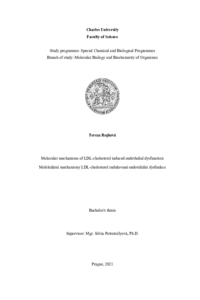Molecular mechanisms of LDL-cholesterol induced endothelial dysfunction
Molekulární mechanismy LDL-cholesterol indukované endoteliální dysfunkce
bakalářská práce (OBHÁJENO)

Zobrazit/
Trvalý odkaz
http://hdl.handle.net/20.500.11956/126303Identifikátory
SIS: 232254
Kolekce
- Kvalifikační práce [19114]
Autor
Vedoucí práce
Oponent práce
Šeda, Ondřej
Fakulta / součást
Přírodovědecká fakulta
Obor
Molekulární biologie a biochemie organismů
Katedra / ústav / klinika
Katedra genetiky a mikrobiologie
Datum obhajoby
31. 5. 2021
Nakladatel
Univerzita Karlova, Přírodovědecká fakultaJazyk
Angličtina
Známka
Výborně
Klíčová slova (česky)
endotel, LDL, cholesterol, endoteliální dysfunkce, aterosklerózaKlíčová slova (anglicky)
endothel, LDL, cholesterol, endothelila dysfunction, atherosclerosisHypercholesterolémie neboli zvýšená hladina LDL-cholesterolu vzniká ať už jako důsledek genetických predispozic, nevhodného životního stylu, přidružených chorob či kombinací těchto faktorů. LDL-cholesterolu se někdy přezdívá "zlý" cholesterol, neboť jeho nadbytek negativně ovlivňuje funkčnost výstelky cév-endotelu, který se vyznačuje svými různorodými účinky, zejména vazodilatační, vazokonstrikční, protizánětlivou a protisrážlivou funkcí, ale také kontrolou propustnosti cév pro látky potřebné tělu a pro buňky imunitního systému. V případě hypercholesterolémie cholesterol postupně kumuluje v subendotheliálním prostoru a vícero mechanismy snižuje hladinu hlavní modulační molekuly endotelu - oxidu dusnatého. Při endotelové dysfunkci vzrůstá oxidační stres, LDL-cholesterol je oxidován a endotelové buňky se aktivují a produkují prozánětlivé cytokiny a adhezivní molekuly. Endotelová dysfunkce je považována za první stupeň aterosklerózy, jelikož se monocyty dostávají do místa zánětu a diferencují v makrofágy, které se následně mění v pěnové buňky endocytózou oxidovaného LDL-cholesterolu. Tímto způsobem jsou vytvářeny aterosklerotické pláty, které nejen cévy zužují, ale také hrozí jejich erupce s následnou trombózou, která může vyústit v další velice závažné kardiovaskulární choroby až smrt. Tato práce...
Hypercholesterolemia, defined as elevated LDL-cholesterol levels in the blood, develops either as a result of genetic predispositions, unhealthy lifestyle, underlying diseases, or as a result of a combination of these factors. LDL-cholesterol is sometimes called "bad" cholesterol because its excess negatively affects the vessel`s innermost layer - endothelium, Endothelium is unique for its vasodilatory, vasoconstrictive, anti-inflammatory, and anti- coagulant function but also for its ability to control vascular permeability. In the case of hypercholesterolemia, cholesterol gradually accumulates in the subendothelial space and reduces levels of the main modulatory molecule of the endothelium - nitric oxide by several mechanisms. In endothelial dysfunction, oxidative stress increases, LDL-cholesterol is oxidized, endothelial cells are activated and produce proinflammatory cytokines and adhesive molecules. Endothelial dysfunction is considered the first stage of atherosclerosis, as monocytes enter the site of inflammation and differentiate into macrophages, which subsequently turn into foam cells by endocytosis of oxidized LDL-cholesterol. In this way, atherosclerotic plaques are formed, which not only narrow the blood vessels, but plaques can erupt, causing subsequent thrombosis, which can result...
